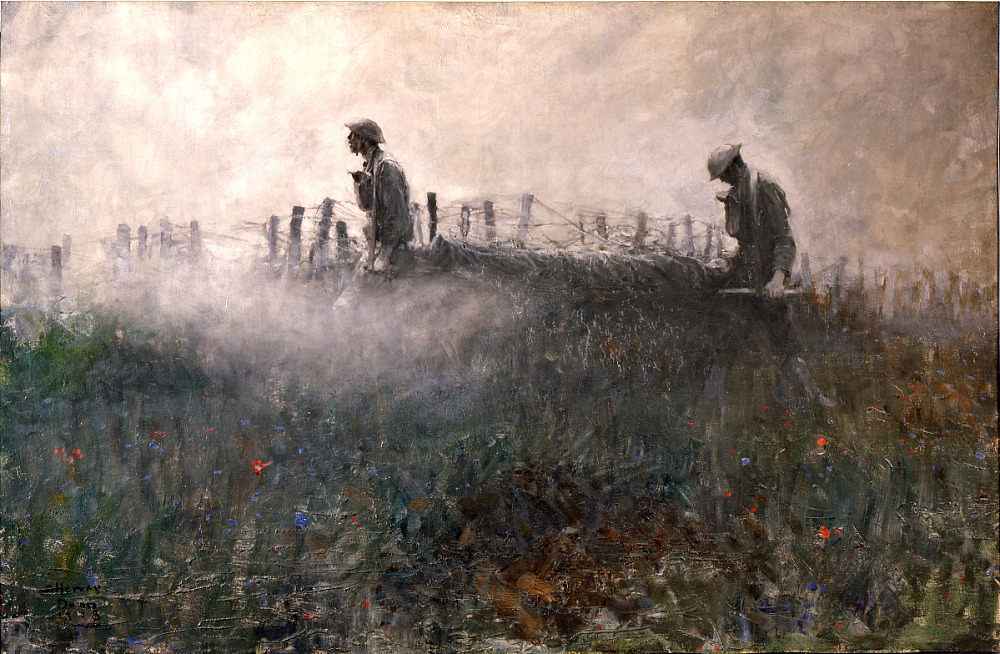Although the United States was the last major power to enter World War I, its soldiers experienced their fair share of fighting. American art noted the prominent importance of this contribution and commemorated it in books, songs, and painting. One of such paintings is “On the Wire,” created in 1918 by Harvey Dunn, one of the artist-correspondents that accompanied the American Expeditionary Force (AEF) in France. The painting, belonging to the National Museum of American History, depicts two American soldiers hurrying along the endless rows of barbed wire and carrying their comrade on the stretchers. While not readily apparent from the distinctly local subject matter, the different parts of the painting reflect the political, socio-economic, and even ideological aspects of war. It reveals American political insistence on having their own sector of the front, the country’s economic unpreparedness for supplying the army for total war, and the remembrance of sacrifices epitomized by the poppy flower.
In political terms, Dunn’s painting indirectly demonstrates the outcome of American insistence on acting independently from the French and the British. The painting focuses on casualties, as the wounded or dead soldier carried by the two stretcher-bearers is its focal point (Dunn). One notable reason for these casualties was purely political. President Wilson wanted “a strong showing on the battlefield to enhance his position at the peace table,” which required the AEF to have its own front sector (Keene 515). However, getting these political gains meant putting American troops into action without direct contact with their more experienced allies, which resulted in increased casualties. For example, an American officer fighting in the frontlines remarked that some soldiers were lost to gas attacks because they did not know the characteristic smell of gas and did not put on gas masks on time (Hockaday). Consequently, Americans lost an average of 820 soldiers per day, as compared to the British figure of 457 (Keene 535). Hence, while not necessarily the artist’s intention, the focus on casualties may reveal the increased casualties that resulted from Wilson’s political demand for a separate front sector.
From a socio-economic perspective, the soldiers’ equipment portrayed in the painting demonstrates the unpreparedness of the American economy to supply its army for total war. American industry caught up eagerly on the opportunity to produce war goods for the government (Keene 513). However, even that was not enough to provide millions of soldiers with everything they needed, and the painting gives ample evidence of that. To begin with, both stretcher-bearers wear the so-called Brodie Helmets recognizable by the wide brim (Dunn). It was a British 1915 design, and the United States had to initially buy several hundred thousand of those from their allies to equip the newly deployed troops (Audoin-Rouzeau 177). It took American industry until 1918 to begin producing the same helmets under license as M1917. Moreover, both soldiers carry gas masks, and these are the French M2, easily identifiable by their characteristic neck-worn poach (Dunn). Thus, if one looks closely enough, many pieces of equipment on the painting reveal themselves as not American-made. In this regard, “On the Wire” reflects the initial difficulties of the American economy in supplying the war.
Finally, the painting also demonstrates the ideological undertones of war participation and commemoration, which were characteristic of World War I. It is not hard to note the small red and blue flowers at the bottom half of the painting, and the red ones are quite likely poppies (Dunn). By 1918, when Dunn created the painting, the red poppy was already associated with the commemoration of the fallen, thanks to John McCrae’s “In Flanders Fields” written in 1915 (Aldritch and Hillard 535). Moreover, in the same 1918, American activist Moina Belle Michael launched an international initiative to wear red poppies as a symbol of respect for the sacrifices made by the veterans (Davila et al. 85). Hence, in the historical context in which Dunn wrote his painting, the red poppy was already firmly established as a commemorative symbol for the Entente’s war effort. With this in mind, its deliberate inclusion into the painting demonstrates the ideological importance assigned to honoring the ordeals endured by the American troops on the frontline.
As one can see, while Dunn’s “On the Wire” seems to be purely local in its focus, it may actually reveal much about the political, socio-economic, and ideological context of World War I. The painting’s emphasis on the dead or wounded soldiers highlights the fact that the AEF suffered high casualties during its active involvement in the fighting. These casualties were partially due to President Wilson’s insistence on the AEF operating independently – a decision made for political gains. Similarly, the British helmets and French gas masks depicted on the painting show that, for all its potential output, the American economy was not initially ready to supply the army with everything it needed. Finally, the small red poppies at the bottom are a clear-cut reference to the ideological importance that the poppy flower as a commemorative symbol assumed by the time of making the painting.
Works Cited
Aldrich, Robert, and Christopher Hilliard. “The French and British Empires.” A Companion to World War I, edited by John Horne, Wiley-Blackwell, 2010, pp. 524-540.
Audoin-Rouzeau, Stephane. “Combat.” A Companion to World War I, edited by John Horne, Wiley-Blackwell, 2010, pp. 171-187.
Davila, Denise, at al. “Military Life in Picturebooks.” Journal of Children’s Literature, vol. 44, no. 2, 2018, pp. 80-86.
Dunn, Harvey T. On the Wire. 1918, National Museum of American History, Washington, D.C.

Hockaday, James K. B. “Letter, 28 Aug. 1918.” The National WWI Museum and Memorial.
Keene, Jennifer D. “The United States.” A Companion to World War I, edited by John Horne, Wiley-Blackwell, 2010, pp. 508-523.